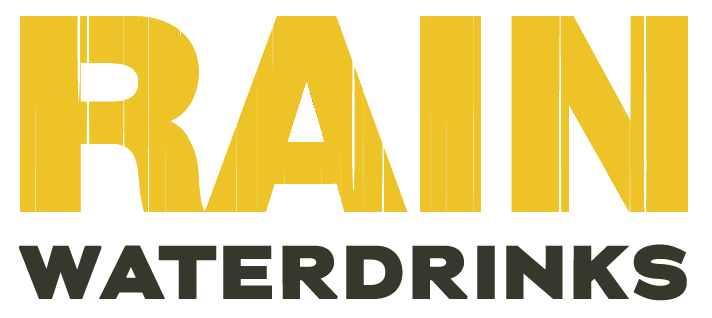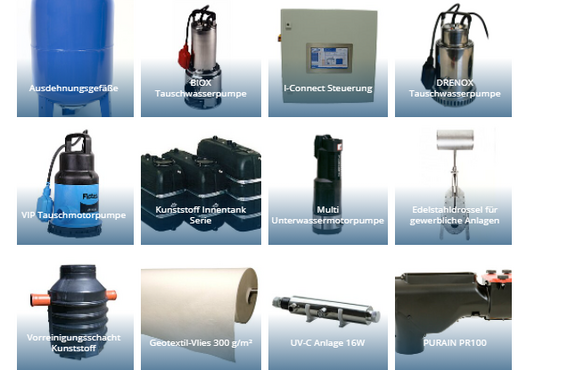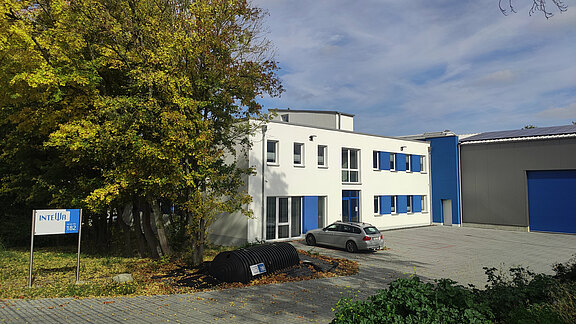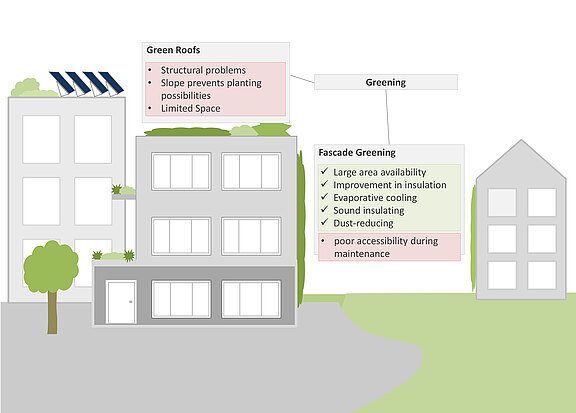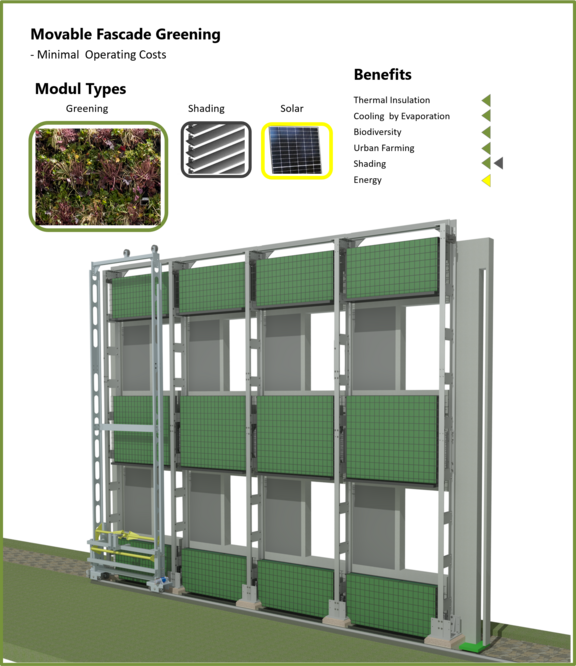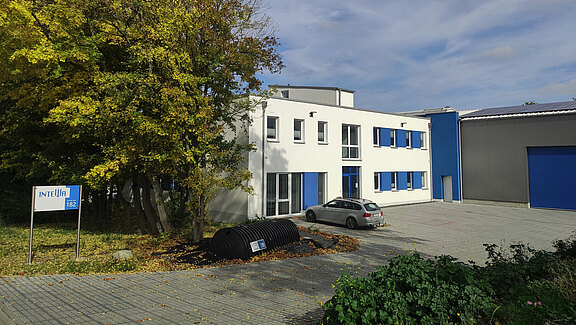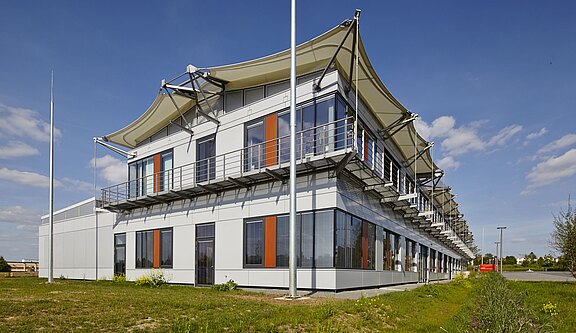MoVe Green - Mobile Vertical Facade Greening
Minimal operating costs • cooling • increasing biodiversity• urban farming • thermal protection
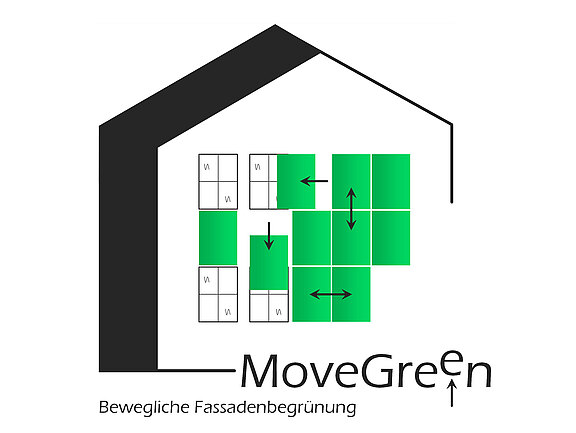
Globally, climate change is leading to locally pronounced, prolonged dry periods without sufficient precipitation. This leads to significant losses in agricultural yields, heat and drought records, and urban heat islands. Green roofs and facades are seen as a key means in cities to contribute to cooling through shading and evaporation effects, to absorb CO2 and to retain rainwater locally. Local regulations and municipal funding programmes are also being adapted to the changed requirements (e.g.: DWA-A/M 102/BWK-A/M 3 "Principles for the management and treatment of stormwater runoff for discharge into surface waters", Berlin Green Roof PLUS programme).
Green roofs vs. green facades
Green roofs are currently the most common form of greening, but they cannot always be retrofitted to existing roofs due to structural problems. In addition, many roofs are not suitable for greening due to their inclination, and the competition for space with technical systems such as ventilation or PV systems is not to be neglected. Thus, the available potential for green roofs is extremely limited and almost always restricted to new buildings.
Compared to roof greening, façade greening has several advantages: The forces of the greening can be introduced into the building walls or into the ground, which makes retrofitting in existing buildings possible. In addition, the areas eligible for façade greening exceed those of greenable roofs several times over in many buildings. Further, not insignificant advantages of façade greening compared to roof greening are the visual effectiveness for urban greening as well as a slight improvement of the insulation value in winter and cooling effect in summer through shading and evapotranspiration. The sound-insulating and dust-reducing effect is also among the measurable advantages. However, there are also glaring disadvantages to the current possibilities of façade greening. For example, due to poor accessibility, especially in multi-storey buildings, care and maintenance lead to increased costs, which too often are not willing to be borne. As a result, façade greening has so far led a niche existence.
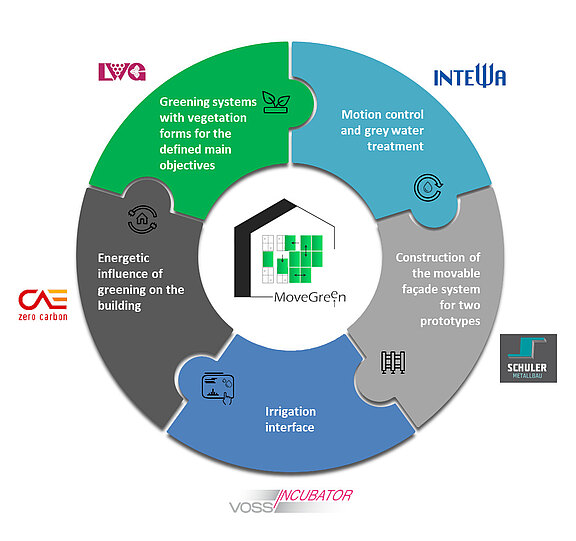
The mobile vertical facade greening: the research and develoment project
To overcome the disadvantages of previous greening solutions, INTEWA has now developed a completely new solution for movable façade greening. As part of the MoVe Green research and development project funded by the German Federal Ministry for Economic Affairs and Climate Protection (FK: 16KN091523) and launched in July 2022, the new solution is being developed and tested by a multidisciplinary consortium of different companies:
The basis for the innovative MoVe Green System is first of all the development and construction of a movable façade system, which is realised by the companies Schuler and INTEWA for different façades and greening modules. The system consists of a pre-wall construction on which the greening elements are suspended. The greening elements are moved on the pre-wall construction with a transport frame (portal), which can be moved both horizontally and vertically via a drive unit, with a movement control system. The irrigation of the greening elements is carried out via a new grey water treatment system using biological treatment and low-thermal plasma. In order to dispense with a complex distribution system, the project partner Voss Automotive is developing a special controlling system for the irrigation at a central service station.
The Bavarian State Institute for Viticulture and Horticulture (LWG) is developing the greening systems for the greening elements and a matrix of vegetation forms for the defined main targets and the vegetation for the demonstrators. The simulation, investigation and evaluation of the energetic influence of the greening on the building for the selected growth forms is carried out by the Center for Applied Energy Research (CAE).
The construction and functionality will be carried out on two prototypes at the INTEWA site in Aachen and CAE in Würzburg and investigated with regard to the irrigation water quality and the energetic influence on the building.
Advantages and possibilities
The movable façade greening with grey water treatment offers numerous advantages compared to conventional façade greening:
- Unlike other non-ground-based façade systems, with MoVe Green the maintenance of the plants (watering, pruning and harvesting) is done from the ground, saving operating costs in the maintenance of the green façade.
- Irrigation with treated greywater from the building minimises the use of drinking water (keyword: "water saving") and reduces the use of fertilisers by utilising the nutrients found in the greywater. The greywater is treated using a cost-effective combination of biological degradation and low-temperature plasma.
- Retrofitting the MoVe Green façade greening system in existing buildings is possible because the system is designed as a pre-wall system and hardly interferes with the statics of the building.
- The movable basic elements allow for diversity of use and should be able to support greening systems, photovoltaic modules and shading elements from different suppliers.
- Façade greening improves the energy efficiency of the building by providing thermal protection in summer and reducing the heating requirements of the buildings in winter.
- The system is also intended to create the possibility for "urban vertical farming" with small space requirements within urban agglomerations.
- Greening increases biodiversity, cools the environment and thus minimises the formation of urban heat islands. The small water cycle is promoted and increases local rainfall.
- The system is controlled via an app so that the movable system can also be used as a sunshade, for example. In the context of urban gardening in front of the window, the app enables "harvesting by touching a button".
- MoVe Green thus contributes to the implementation of SDGs 3 (health and well-being), 7 (affordable and clean energy), 9 (industry, innovation and infrastructure), 11 (sustainable cities and communities) and 13 (climate action).
- The movable, green elements increase the aesthetics of the buildings, the well-being of the residents and contribute to an increase in value for the property owner.
Conclusion & Perspective
MoVe Green expands the application field of façade greening through reduced maintenance costs, an efficient irrigation solution and a large number of possible combinations for use. In this context, MoVe Green is still open for associated partners, for example with expertise in the fields of AI, digitalisation, photovoltaics, etc., until the end of the project in March 2025. Contact us for more information: ringelstein@intewa.de!
Author: Oliver Ringelstein
Further information:
MoVe Green research project:
https://www.intewa.com/de/forschung-und-entwicklung/movegreen/
Greywater recycling:
https://www.intewa.com/de/wasseraufbereitung/gewerbe/grauwasser-recycling/
Rainwater harvesting:
https://www.intewa.com/de/wasseraufbereitung/gewerbe/regenwassernutzung/
Stormwater management:

